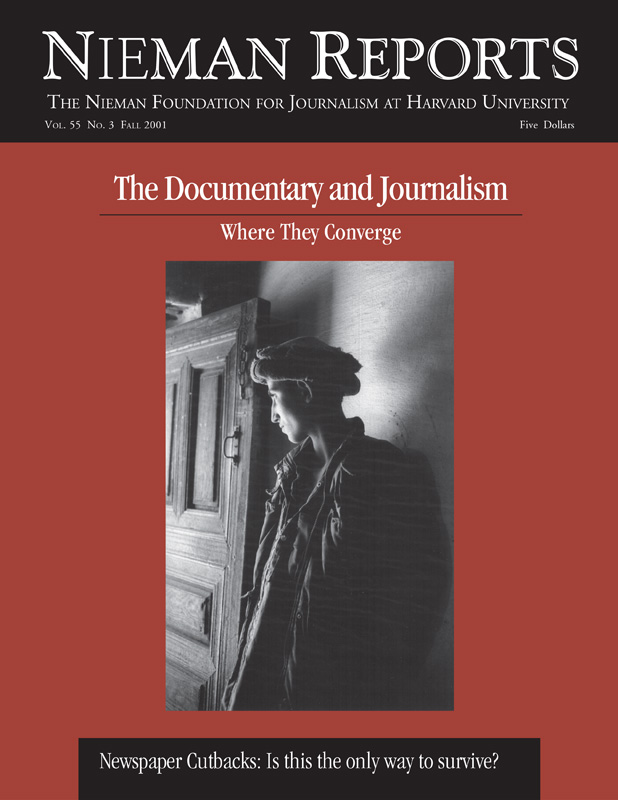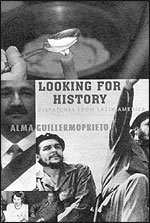
The Documentary and Journalism: Where They Converge
At a time when so much of journalism is quicker, shorter and hyped to grab the public’s presumed short-attention span, the documentary—with its slower pace and meandering moments—is finding receptive audiences in many old places and some new ones as well. In this issue of Nieman Reports, we’ve asked those who document our world to explore how their work converges with ours. How is what they do related to journalism? And what does the documentary form allow its adherents to do in reporting news or exploring issues that other forms of journalism do not?

Looking for History: Dispatches From Latin America
Alma Guillermoprieto
Pantheon. 303 Pages. $25.America and the Americas are often two concepts that those of us living in the United States have trouble grasping. We think of America as limited to only the United States. Yet travel the whole of the Americas and its citizens will tell you that they, too, are Americans with their own histories, their own pursuits of liberty and justice.
And so Mexico-born writer Alma Guillermoprieto tells us simply and bluntly that she wrote her new book, “Looking for History,” with the “conviction that Latin America has its own independent life.”
What emerges is a collection of 17 essays that take readers through the sad psychological and political battles of Colombians, Cubans and Mexicans—all from countries that shape U.S. policy like no others in the Western Hemisphere. Interspersed are profiles of the Argentineans Evita Perón and Che Guevara and Peruvian Mario Vargas Llosa.
Nearly half of the book is devoted to a series of scarcely believable tales from Mexico, where Guillermoprieto was born and returned to live in the mid-1990’s. All of these essays appeared in The New Yorker and in The New York Review of Books between 1994 and 2000.
In this book, Guillermoprieto is at her best in her psychological portraits of Latin America’s unconventional politicos. Among them are Vargas Llosa, the Peruvian writer who lost a presidential bid; Guevara, the icon by which the Latin American left defined itself, and Vicente Fox, the Mexican rancher who dethroned a corrupt political machine to take the presidency.
Guillermoprieto makes it clear why Vargas Llosa, an author of inspiring prose, failed miserably in his presidential bid. He wasn’t much of a patriot, having written, “Although I was born in Peru, my vocation is that of a cosmopolitan and an expatriate who has always detested nationalism.”
Her essay about Vargas Llosa also opens up a window into a cruel theme—what Guillermoprieto calls a fundamental trait of Peruvians, but is very much a continuing problem of Latin America and those in the diaspora to the United States. These nations and their peoples are constantly immersed in conflict over their mixed blood and class. It’s “the deep-seated explanation for the conflicts and frustrations of Peruvian life,” Guillermoprieto writes.
In her artfully handled essay on Che, it’s easy to understand why Guillermoprieto, with her sympathies for the poor, was drawn to Che as a subject matter. Here she dissects three weighty tomes, published in 1997, on Che. And in doing so she quickly takes the reader into her generation’s own psyche. “Guevara was born in Latin America’s hour of the hero,” she writes. “So many of our leaders have been so corrupt, and the range of allowed and possibly public activity has been so narrow, and injustice has cried out so piercingly to the heavens, that only a hero can answer the call, and only a heroic mode of life could seem worthy. Guevara stood out against the inflamed horizon of his time, alone and unique.” She sees Che’s flaws, though. With horizon inflamed, a generation of followers were “incinerated” by their Che ideology. In a very personal passage, she details how those “children of Che” armed in radical revolution would die, including a great friend of Guillermoprieto’s mother, a poet and feminist editor named Alaíde Foppa. And by synthesizing details from a book by Jon Anderson, she shows how Che, this man of the people, was a machista of an elitist background who would have his sexual way with the family maids. She writes that Guevara’s slogans now sound foolish. And she highlights that with work from a book by Jorge Castaneda, a political scientist who is now Mexico’s foreign minister.
Castaneda’s Che is a man who cannot bear the natural ambivalence of the world, a world of gray where people have mixed allegiances. As the eventual head of the Central Bank, for example, Che was flummoxed by day-to-day realities of running a government. “Why corrupt workers by offering them more money to work harder?” Given the region’s history of rickety economies, the reader wonders if a Latin American could be found today who shares that view.
The Mexican section is full of painful reading. It’s devoted largely to the opera buffa that Mexico became during the years that Carlos Salinas reigned in the imperial presidency and the years that followed when the sober economist Ernesto Zedillo took over the script. These are librettos of sex, drugs, murder and guerrilla uprisings, unearthed skeletons, and paid informants who worked as sorcerers. The material is interwoven with a few topsy-turvy plot twists in which heroes frequently became villains.
The book’s “Losing the Future” is a small essay about a large tragedy. It deals with the assassination of Luis Donaldo Colosio, the virtual president of Mexico, in a hilly slum named after bullfighting in Tijuana. On March 23, 1994, the candidate was shot in the head at close range. A lynching mob surrounded the man believed to be the assassin. The details of the hysteria and the hugely disorganized investigation that followed in Tijuana are left out of the book. Instead, the author focuses on Mexico City and the tremors in the seat of power. The discipline that had kept the Institutional Revolutionary Party together for an astonishing number of years after the Mexican Revolution no longer exists, she wrote in a 1994 dispatch. But it would take another six years to fully knock the corrupt ruling party from power in Los Piños, the pine-studded presidential complex in the polluted capital.
And when the reader fast-forwards to July 2000, there is at last a sense of optimism. It is in the portrait of Fox, the rancher who took the Mexican presidency from the ruling party, and in a smaller snapshot of a political activist named Sergio Aguayo, who built an organization called Alianza Cívica to insure clean, not just cleaner, elections in Mexico.
Guillermoprieto takes note of the “nutty extremes” to which Fox will take his rhetoric: He is the man who, after all, first came to the Mexican public’s attention by looping a pair of paper voting ballots over his ears in an attempt to make fun of the protruding ears of then-president Carlos Salinas.
The hope comes in her elegant passages with Aguayo, who as a young member of the feared Los Vikingos battled an opposing gang linked to the ruling party in Guadalajara. Aguayo is now in his early 50’s. The night after the elections, the author calls Aguayo to see how he fared in his bid for a seat in Congress. “Isn’t it wonderful?” he asked. Assuming he’d won, Guillermoprieto answered that she was delighted to congratulate him on his victory. “What, me?” he said. “Oh, no, I lost. But the PRI lost, too, and that’s just marvelous.” Finally, a Mexican subject with the dignity of a patriot.
Guillermoprieto’s reputation was honed in the wars of Central America. As a Washington Post reporter, she was one of only two journalists to travel to El Salvador and report on a horrific 1981 massacre at El Mozote conducted by a U.S.-trained Salvadoran army.
“Looking for History” illustrates Guillermoprieto’s veteran ability to rush into what sometimes seems madness and expose the nervous system of countries struggling with great change. While her previous book, “The Heart That Bleeds: Latin America Now,” dealt with common experiences of Latin Americans in a set of chronicles from an earlier period, “Looking for History” deals largely with politics. Those looking for heart-that-bleeds chronicles of windowpane fitters, garbage collectors and ranchera singers will find few essays that are similar. One exception: “The Children’s War,” a penetrating essay from Colombia on girl guerrillas, cocaine and U.S. military aid.
But this book should more than satisfy anyone looking for Guillermoprieto’s ear and eye for detail and her poetic metaphors. And those wanting to learn more about the region’s politics will be equally enriched.
Dianne Solís, a 1990 Nieman Fellow, is a writer for The Dallas Morning News. She was formerly based in Mexico City for The Wall Street Journal in 1991 through 1997.


